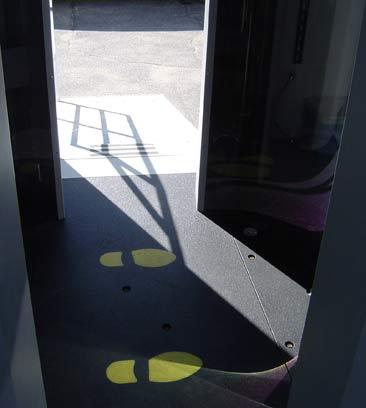|
|
| In the year 2028 |
| By Ann Coppola, News Reporter |
| Published: 03/10/2008 |
 Resisting a reference to Doc Brown and his DeLorean time machine is tough, especially since last week’s Northeast Technology and Product Assessment Committee (NTPAC) spring meeting so successfully brought the focus of its corrections audience “back to the future.” The committee’s two days of forward-looking training and vendor presentations drew 30 participants from the Northeast and Colorado, and included wardens, directors, and security and technology specialists.
Resisting a reference to Doc Brown and his DeLorean time machine is tough, especially since last week’s Northeast Technology and Product Assessment Committee (NTPAC) spring meeting so successfully brought the focus of its corrections audience “back to the future.” The committee’s two days of forward-looking training and vendor presentations drew 30 participants from the Northeast and Colorado, and included wardens, directors, and security and technology specialists.“I’ve been very impressed by the turnout and the variety of agencies represented,” said American Correctional Association Executive Director James Gondles, a first-time attendee. “NTPAC has been more active if not the most active group in technology use in corrections in any area of the country.” The purpose of NTPAC’s gatherings is to identify and evaluate new concepts and technologies that have the potential to make a significant impact on the corrections field. Day one had the group imagining the state of the world 20 years from now when the Federal Bureau of Prisons (BOP) presented its Forward Thinking Initiative. To be a forward thinker or “futurist,” one has to identify possible future social, economic, and other trends, imagine the scenarios they could create, and analyze the impact they would have on the world. “What if the mandatory retirement age is raised? How will that impact the workforce?” asked presenter Louis Eichenlaub of the BOP, who encouraged the audience to think openly and globally. “What about the legalization of drugs? Our largest population is drug offenders, think about how that would change how we operate. That’s a wildcard in our industry.” Wildcard scenarios are especially useful to futurists because even though these events are unlikely to happen, their impact would be far-reaching. At a previous Bureau training, a Coast Guard representative credited futurism as a major reason for the agency’s highly successful response to Hurricane Katrina. The Bureau has been conducting trainings in futurism once a year for the past five years, and it believes it’s time for corrections to fully utilize the concept. “We want everyone to think like this,” Eichenlaub added. “The idea is to incorporate forward thinking into your agency’s strategic planning, and take it to that next level.” Despite some early skepticism, the foray into the future earned a lot of positive feedback. “I will certainly bring what I’ve learned back to ACA,” Gondles said. “We’ve been working with Forward Thinking ourselves, especially in terms of the recruiting challenges we will face across the country.” “I’m trying to bring futurist thinking to our corrections technology working group,” added Stanley Erickson, Science Advisor for the National Institute of Justice Office of Science and Technology. “We mostly fund short-term, ready-for-prime-time technologies, but I want us to consider the more long-term technological requirements for corrections.” On the vendor side of things, the committee got hands-on experience with four new technologies and debated which ones will be coming soon to a facility near you. GE Global Research introduced a sensor that detects pulsations from the heart and lungs and could potentially alert correctional staff if an inmate is attempting suicide by self-asphyxiation. The modified Doppler radar technology, which received a 12-month, $460,000 NIJ fund, is still in the very early stages.  The suicide prevention sensor “It’s clearly in its infancy, but I think given the challenges we’re facing regarding suicides, we should encourage them to keep going,” said Commissioner Harold Clarke of the Massachusetts Department of Corrections. The committee also looked at a pair of contraband detection technologies, testing a non-ferrous metal detector from GE Homeland Protection and a millimeter wave-imaging body scanner from L-3 Communications. The enthusiasm for the millimeter-wave body imager, which can detect metals, ceramics, plastics, and even liquids, was high. The technology is already being used in Iraq’s Green Zone, security checkpoints in Afghanistan, and a few correctional facilities throughout the U.S. The committee was optimistic about further adapting the scanner to correctional environments.  Step into the body imager Lastly, the group heard from JPay, Inc. about its inmate services platform for electronic trust account payments, release debit cards, inmate electronic mail and video visitation. One of the most popular functions for practitioners is the JPay mail system. Inmates’ families and friends can send letters from JPay.com, and the emails are easy for mailroom staff to read and don’t require any opening of envelopes. “We love JPay because overall it increases the contact between inmates and their families,” said Colorado Department of Corrections Director of Prisons Tony Carochi. Between all of the lively debates, one theme that emerged was the desire to improve the collaboration between the scientific and corrections communities. “I’m in favor of trying to get people from the scientific community integrated into corrections,” said Paul Biermann of the Applied Physics Laboratory at Johns Hopkins University. “The better the understanding we have of what the prison environment is really like, the safer we can make that environment for inmates and COs.” “We need to invite individuals testing new technology into the system to give them that real experience as they address their work,” agreed Clarke. “It’s going to play to our benefit.” As NTPAC looks towards its summer meeting, a companion organization will be spreading its wings out west. The Rocky Mountain Technology Assessment Committee, an effort led by the Colorado Department of Corrections, is planning its first-ever meeting for the first week of May. “We want to put something like this in place in the western part of the country so we’re not reinventing the wheel all the time,” said CODOC Executive Director Aristedes Zavaras. “We’re under the microscope right now for the financial strain we’re putting on state budgets, and identifying and selecting the best technology out there makes us more efficient and saves money.” The Colorado contingent has a lot of hope for its grass roots technology group, based on the growing interest and crowds NTPAC continues to draw with each of its meetings. With any luck, the Rocky Mountain version of NTPAC will have just as much success. Related Resources: See what a millimeter wave body scan looks like |
MARKETPLACE search vendors | advanced search

IN CASE YOU MISSED IT
|


Comments:
Login to let us know what you think